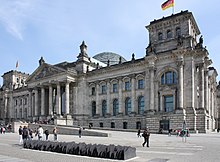Albert Kayser
Albert Kayser (born November 28, 1898 in Stettin ; † October 18, 1944 in Buchenwald concentration camp ) was a German communist politician and resistance fighter against National Socialism .
Political biography
Albert Kayser was a worker and later a union shop steward at Siemens in Berlin . In 1921 he joined the KPD . Dismissed by Siemens after a strike in 1923, Kayser then worked for the Berlin transport company , where he was elected chairman of the works council at the end of the 1920s and, as a member of the strike leadership, played a key role in the organization of the workforce's supra-regional strike ( see strike at the Berlin transport company in 1932 ). In July 1932 and March 1933 Kayser was elected to the Reichstag.
On the night of the Reichstag fire , he was arrested - at the same time as thousands of other KPD cadres - and then held in the Sonnenburg concentration camp until December 23, 1933 . After the arrest of Martin Schwantes , the Berlin state leadership of the KPD appointed Kayser as a senior adviser authorized to issue instructions for the instructing area in Central Germany. In this function he was responsible for direct guidance to the party districts of Thuringia , Halle-Merseburg and Magdeburg - Anhalt . As one of nine senior advisors active in the Reich territory, Kayser, who moved into illegal quarters at Wörmlitzer Strasse 3 in Halle under the code name Robert Erdmann, was a key player in the KPD's underground apparatus at this stage.
On January 26, 1935, Kayser was surprised by Gestapo officers at an illegal meeting at Thüringer Straße 26 in Halle and - together with Wilhelm Künzler , Helene Glatzer and the apartment owner Hans Lehnert - arrested for organizing a "treasonable consultation". The arrested people were beaten at the police station in Merseburger Strasse when their personal details were taken and then tortured for days in the police headquarters on Hallmarkt and in the remand prison on Kleine Steinstrasse. Helene Glatzer succumbed to the injuries suffered on January 31. At the beginning of August 1935, Kayser was sentenced to death by the 1st Senate of the People's Court for preparing for high treason . When Kayser was taken away after the judgment had been read out, he is said to have shouted “Rot Front, Comrades!” To co-defendants Minna Herm , Wilhelm Künzler, Franz Urbanski and Josef Pfaff. The verdict against the former Reichstag deputy, widely discussed in the Nazi press under headings such as “No place for central German agitators” and “Elimination of central German agitators”, caused a stir and protests internationally and, not least, contributed to the fact that top functionaries of the SPD and KPD met for joint deliberations (see Lutetia circle ). Since this was extremely unpleasant for the regime in the immediate run-up to the Olympic Games in 1936 , the death sentence against Kayser was finally commuted to life imprisonment. In a parallel process the same Kayser on the basis of more stringent on April 24, 1934 Tatbestands- and punitive provisions in case of "high treason" - was now given in by interested interpretation in any kind of activity for the illegal KPD - sentenced to death Rudolf Claus , however, was executed on December 17, 1935.
Initially held in Plötzensee prison and from February 1936 in Brandenburg-Görden prison , Kayser was transferred to Buchenwald concentration camp on December 21, 1943 , where he fell ill with typhus and died in October 1944 . An illegal funeral service for Kayser was held in the camp on October 22nd.
Subject of the politics of remembrance
The memorial plaque for Kayser and Otto Schmirgal on the BVG building at Rosa-Luxemburg-Straße 2 was removed by strangers after 1990. A Berlin housing cooperative that has had Kayser's name since 1974 abandoned it after 1990.
Since 1992 one of the 96 memorial plaques for members of the Reichstag murdered by the National Socialists has been commemorating Kayser near the Bundestag building . In October 2012 , a stumbling block was laid for him in front of his former home in Berlin-Wedding , Groninger Strasse 22 . Kayser's grave - now an honorary grave for the State of Berlin - is located in the urn cemetery on Seestrasse in Wedding .
There is now a new memorial plaque in the entrance area of the BVG headquarters, Holzmarktstrasse 15.
literature
- Kayser, Albert . In: Hermann Weber , Andreas Herbst : German Communists. Biographical Handbook 1918 to 1945 . 2nd, revised and greatly expanded edition. Karl Dietz, Berlin 2008, ISBN 978-3-320-02130-6 .
Web links
- Albert Kayser in the database of members of the Reichstag
Individual evidence
- ↑ See Suffering, Karl-Heinz (among others), Against Fascism and War. The KPD in the Halle-Merseburg district 1933 to 1945, Halle (Saale) 1983, pp. 205f.
- ↑ See Suffering, Against Fascism and War, pp. 119, 206.
- ↑ See Suffering, Against Fascism and War, pp. 218f.
- ↑ See Suffering, Against Fascism and War, pp. 232f.
- ↑ See Suffering, Against Fascism and War, p. 233.
- ↑ See National Memorial Buchenwald (ed.), Buchenwald - Warning and Obligation. Documents and reports, 4th, completely revised edition, Berlin 1983, pp. 141, 479, 748.
- ^ Photo of the memorial plaque in the German Digital Library
- ↑ Memorial plaque for Albert Kayser and Otto Schmirgal on www.gedenkenafeln-in-berlin.de
| personal data | |
|---|---|
| SURNAME | Kayser, Albert |
| BRIEF DESCRIPTION | German politician (KPD), MdR |
| DATE OF BIRTH | November 28, 1898 |
| PLACE OF BIRTH | Szczecin |
| DATE OF DEATH | October 18, 1944 |
| Place of death | Buchenwald concentration camp |


